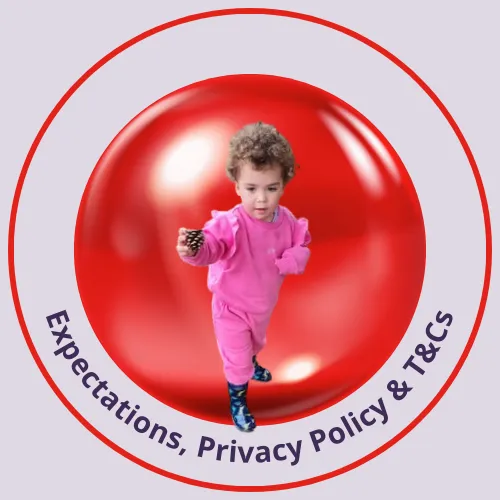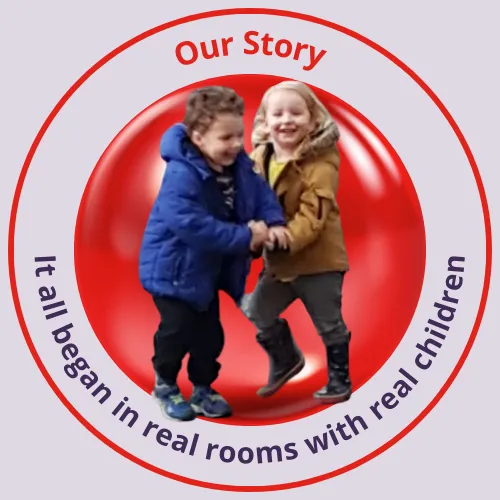Every child's well-being matters.
Well-being Articles

Recognising the Signs of Burnout in Early Years Practitioners
Working in an early years setting is rewarding but also demanding. The emotional, physical, and mental pressures can take a toll, leading to burnout if not recognised and addressed early. Burnout affects not only practitioners but also the children in their care, making it a crucial safeguarding and wellbeing concern.
What is Burnout?
Burnout is a state of emotional, physical, and mental exhaustion caused by prolonged stress. In nurseries and preschools, it can develop due to high workloads, long hours, emotional strain from supporting children and families, and limited resources. If left unaddressed, burnout can lead to reduced job satisfaction, increased absenteeism, and even compromise the quality of care provided to children.
Signs of Burnout in Early Years Practitioners
Recognising the early warning signs can help prevent burnout from escalating. Common indicators include:
Emotional exhaustion – Feeling drained, overwhelmed, or detached from work.
Reduced patience and empathy – Becoming irritable, struggling to connect with children and colleagues.
Increased absenteeism – Taking more sick days due to stress or exhaustion.
Declining job satisfaction – Feeling unmotivated or questioning career choices.
Physical symptoms – Frequent headaches, stomach issues, or difficulty sleeping.
Difficulty concentrating – Struggling to complete tasks or make decisions.
How Burnout Affects Safeguarding
Burnout can have serious safeguarding implications. Practitioners who are emotionally drained may struggle to stay vigilant, making it harder to spot signs of neglect or abuse in children. It can also impact their ability to respond appropriately to challenging behaviour, maintain professional boundaries, or support children’s emotional wellbeing effectively.
Preventing and Addressing Burnout
Nursery and preschool leaders play a crucial role in preventing burnout and promoting staff wellbeing. Key strategies include:
Regular supervision and support – Encourage open conversations about stress and workload.
Staff wellbeing initiatives – Promote a culture of self-care, encourage breaks, and provide mental health support.
Manageable workloads – Ensure staffing levels are sufficient to prevent overwork (easier said than done, we know!)
Training and development – Provide opportunities for professional growth and resilience-building.
Work-life balance – Encourage staff to switch off from work outside of hours.
By recognising the signs of burnout and putting measures in place to support early years practitioners, settings can create a healthier, more positive environment for both staff and children. Addressing burnout is not just about improving workplace satisfaction—it is a vital safeguarding issue that ensures children receive the best possible care from engaged, attentive, and well-supported professionals.
AUTHOR:- Iona has nearly 10 years of experience supporting nurseries and childminders in curriculum planning, leadership, and safeguarding. Her writing is informed by public information and sector insight, aiming to provide accessible, practical support for professionals working with children. She is part of the On the Button team, helping deliver Well-being, Safeguarding and Complaint Management Software that empowers practitioners to identify concerns early and act confidently.
On the Button provides innovative software tailored to the needs of the early years sector, with a strong focus on EYFS well-being and early years safeguarding. Our tools help senior practitioners to confidently track concerns, maintain robust records, and respond effectively — all while meeting statutory guidance. From early years complaint management to team-wide safeguarding alerts, our platform puts children's safety and emotional health first.

Recognising the Signs of Burnout in Early Years Practitioners
Working in an early years setting is rewarding but also demanding. The emotional, physical, and mental pressures can take a toll, leading to burnout if not recognised and addressed early. Burnout affects not only practitioners but also the children in their care, making it a crucial safeguarding and wellbeing concern.
What is Burnout?
Burnout is a state of emotional, physical, and mental exhaustion caused by prolonged stress. In nurseries and preschools, it can develop due to high workloads, long hours, emotional strain from supporting children and families, and limited resources. If left unaddressed, burnout can lead to reduced job satisfaction, increased absenteeism, and even compromise the quality of care provided to children.
Signs of Burnout in Early Years Practitioners
Recognising the early warning signs can help prevent burnout from escalating. Common indicators include:
Emotional exhaustion – Feeling drained, overwhelmed, or detached from work.
Reduced patience and empathy – Becoming irritable, struggling to connect with children and colleagues.
Increased absenteeism – Taking more sick days due to stress or exhaustion.
Declining job satisfaction – Feeling unmotivated or questioning career choices.
Physical symptoms – Frequent headaches, stomach issues, or difficulty sleeping.
Difficulty concentrating – Struggling to complete tasks or make decisions.
How Burnout Affects Safeguarding
Burnout can have serious safeguarding implications. Practitioners who are emotionally drained may struggle to stay vigilant, making it harder to spot signs of neglect or abuse in children. It can also impact their ability to respond appropriately to challenging behaviour, maintain professional boundaries, or support children’s emotional wellbeing effectively.
Preventing and Addressing Burnout
Nursery and preschool leaders play a crucial role in preventing burnout and promoting staff wellbeing. Key strategies include:
Regular supervision and support – Encourage open conversations about stress and workload.
Staff wellbeing initiatives – Promote a culture of self-care, encourage breaks, and provide mental health support.
Manageable workloads – Ensure staffing levels are sufficient to prevent overwork (easier said than done, we know!)
Training and development – Provide opportunities for professional growth and resilience-building.
Work-life balance – Encourage staff to switch off from work outside of hours.
By recognising the signs of burnout and putting measures in place to support early years practitioners, settings can create a healthier, more positive environment for both staff and children. Addressing burnout is not just about improving workplace satisfaction—it is a vital safeguarding issue that ensures children receive the best possible care from engaged, attentive, and well-supported professionals.
AUTHOR:- Iona has nearly 10 years of experience supporting nurseries and childminders in curriculum planning, leadership, and safeguarding. Her writing is informed by public information and sector insight, aiming to provide accessible, practical support for professionals working with children. She is part of the On the Button team, helping deliver Well-being, Safeguarding and Complaint Management Software that empowers practitioners to identify concerns early and act confidently.
On the Button provides innovative software tailored to the needs of the early years sector, with a strong focus on EYFS well-being and early years safeguarding. Our tools help senior practitioners to confidently track concerns, maintain robust records, and respond effectively — all while meeting statutory guidance. From early years complaint management to team-wide safeguarding alerts, our platform puts children's safety and emotional health first.

Recognising the Signs of Burnout in Early Years Practitioners
Working in an early years setting is rewarding but also demanding. The emotional, physical, and mental pressures can take a toll, leading to burnout if not recognised and addressed early. Burnout affects not only practitioners but also the children in their care, making it a crucial safeguarding and wellbeing concern.
What is Burnout?
Burnout is a state of emotional, physical, and mental exhaustion caused by prolonged stress. In nurseries and preschools, it can develop due to high workloads, long hours, emotional strain from supporting children and families, and limited resources. If left unaddressed, burnout can lead to reduced job satisfaction, increased absenteeism, and even compromise the quality of care provided to children.
Signs of Burnout in Early Years Practitioners
Recognising the early warning signs can help prevent burnout from escalating. Common indicators include:
Emotional exhaustion – Feeling drained, overwhelmed, or detached from work.
Reduced patience and empathy – Becoming irritable, struggling to connect with children and colleagues.
Increased absenteeism – Taking more sick days due to stress or exhaustion.
Declining job satisfaction – Feeling unmotivated or questioning career choices.
Physical symptoms – Frequent headaches, stomach issues, or difficulty sleeping.
Difficulty concentrating – Struggling to complete tasks or make decisions.
How Burnout Affects Safeguarding
Burnout can have serious safeguarding implications. Practitioners who are emotionally drained may struggle to stay vigilant, making it harder to spot signs of neglect or abuse in children. It can also impact their ability to respond appropriately to challenging behaviour, maintain professional boundaries, or support children’s emotional wellbeing effectively.
Preventing and Addressing Burnout
Nursery and preschool leaders play a crucial role in preventing burnout and promoting staff wellbeing. Key strategies include:
Regular supervision and support – Encourage open conversations about stress and workload.
Staff wellbeing initiatives – Promote a culture of self-care, encourage breaks, and provide mental health support.
Manageable workloads – Ensure staffing levels are sufficient to prevent overwork (easier said than done, we know!)
Training and development – Provide opportunities for professional growth and resilience-building.
Work-life balance – Encourage staff to switch off from work outside of hours.
By recognising the signs of burnout and putting measures in place to support early years practitioners, settings can create a healthier, more positive environment for both staff and children. Addressing burnout is not just about improving workplace satisfaction—it is a vital safeguarding issue that ensures children receive the best possible care from engaged, attentive, and well-supported professionals.
AUTHOR:- Iona has nearly 10 years of experience supporting nurseries and childminders in curriculum planning, leadership, and safeguarding. Her writing is informed by public information and sector insight, aiming to provide accessible, practical support for professionals working with children. She is part of the On the Button team, helping deliver Well-being, Safeguarding and Complaint Management Software that empowers practitioners to identify concerns early and act confidently.
On the Button provides innovative software tailored to the needs of the early years sector, with a strong focus on EYFS well-being and early years safeguarding. Our tools help senior practitioners to confidently track concerns, maintain robust records, and respond effectively — all while meeting statutory guidance. From early years complaint management to team-wide safeguarding alerts, our platform puts children's safety and emotional health first.

Recognising the Signs of Burnout in Early Years Practitioners
Working in an early years setting is rewarding but also demanding. The emotional, physical, and mental pressures can take a toll, leading to burnout if not recognised and addressed early. Burnout affects not only practitioners but also the children in their care, making it a crucial safeguarding and wellbeing concern.
What is Burnout?
Burnout is a state of emotional, physical, and mental exhaustion caused by prolonged stress. In nurseries and preschools, it can develop due to high workloads, long hours, emotional strain from supporting children and families, and limited resources. If left unaddressed, burnout can lead to reduced job satisfaction, increased absenteeism, and even compromise the quality of care provided to children.
Signs of Burnout in Early Years Practitioners
Recognising the early warning signs can help prevent burnout from escalating. Common indicators include:
Emotional exhaustion – Feeling drained, overwhelmed, or detached from work.
Reduced patience and empathy – Becoming irritable, struggling to connect with children and colleagues.
Increased absenteeism – Taking more sick days due to stress or exhaustion.
Declining job satisfaction – Feeling unmotivated or questioning career choices.
Physical symptoms – Frequent headaches, stomach issues, or difficulty sleeping.
Difficulty concentrating – Struggling to complete tasks or make decisions.
How Burnout Affects Safeguarding
Burnout can have serious safeguarding implications. Practitioners who are emotionally drained may struggle to stay vigilant, making it harder to spot signs of neglect or abuse in children. It can also impact their ability to respond appropriately to challenging behaviour, maintain professional boundaries, or support children’s emotional wellbeing effectively.
Preventing and Addressing Burnout
Nursery and preschool leaders play a crucial role in preventing burnout and promoting staff wellbeing. Key strategies include:
Regular supervision and support – Encourage open conversations about stress and workload.
Staff wellbeing initiatives – Promote a culture of self-care, encourage breaks, and provide mental health support.
Manageable workloads – Ensure staffing levels are sufficient to prevent overwork (easier said than done, we know!)
Training and development – Provide opportunities for professional growth and resilience-building.
Work-life balance – Encourage staff to switch off from work outside of hours.
By recognising the signs of burnout and putting measures in place to support early years practitioners, settings can create a healthier, more positive environment for both staff and children. Addressing burnout is not just about improving workplace satisfaction—it is a vital safeguarding issue that ensures children receive the best possible care from engaged, attentive, and well-supported professionals.
AUTHOR:- Iona has nearly 10 years of experience supporting nurseries and childminders in curriculum planning, leadership, and safeguarding. Her writing is informed by public information and sector insight, aiming to provide accessible, practical support for professionals working with children. She is part of the On the Button team, helping deliver Well-being, Safeguarding and Complaint Management Software that empowers practitioners to identify concerns early and act confidently.
On the Button provides innovative software tailored to the needs of the early years sector, with a strong focus on EYFS well-being and early years safeguarding. Our tools help senior practitioners to confidently track concerns, maintain robust records, and respond effectively — all while meeting statutory guidance. From early years complaint management to team-wide safeguarding alerts, our platform puts children's safety and emotional health first.




Facebook
Instagram
LinkedIn
Youtube